Several years ago, one of the wilderness organizations that is prominent in the environmental lobby moved its offices from downtown Washington, D.C. to one of the city’s leafy suburbs, thus violating one of the cardinal rules of the lobby, to wit: Thou shalt urbanize.
The organization caught a few barbs from the media for the move, but by and large the announcement escaped any close scrutiny or discussion. Construction industry lobbyists left the issue alone, preferring to concentrate on communicating the industry’s positive points to elected officials and the news media.
You can’t fault the construction lobby’s strategy or tactics, but it’s a shame in many ways that we did not have a national debate over the conflict between environmentalists’ desires to urbanize America and the realities of the market place.
The environmentalist group that moved to the suburbs did so because its office space there was dramatically cheaper than in town. That is the same reason tens of thousands of other businesses have done the same thing over the years. It is also the same reason that millions and millions of American families have chosen to locate in the suburbs.
For vast numbers of our citizens and businesses, large inner cities are not cost efficient.
While the environmental lobby would like to force urbanization on our sprawling metropolitan areas by making highway transportation impractical, they are missing the real problem: Roads don’t cause urban flight, opportunity does. The more you make movement in and near the city impossible, the more the population will spread into the hinterlands.
We are reversing the urbanization of America that happened in the mid-20th century, especially after World War II when millions of rural-born Americans migrated to the great cities in search of opportunity. The jobs that brought those multitudes to the cities began migrating to the suburbs in the 70s and are now drifting out to the exurbs, to the small cities and towns that were considered rural centers in the 1940s.
Want to make cities more attractive for businesses and residents? Give them some competitive advantages. Reduce the cost differential. Where are the advantages for high-population-density living? Most services cost more in the city than they do in the suburbs, even the established suburbs. Taxes are higher. Roads are worse. Housing costs far more for much less. Many cities’
public schools are so bad that middle class residents have to factor in private school tuition. Public transportation is more feasible than outside the cities, but only in New York City is it so extensive as to eliminate the need for a car.
The objections to locating families and business in inner cities can’t be overcome by forcing bad roads on the suburbs and the exurbs. All that will do is stimulate more migration outward and exacerbate the problem of sprawl.
Roads are not a threat to cities. Roads take people and businesses where they want to go, and good roads take them there efficiently. When cities are desirable places for people and businesses, roads will get them there, and good roads will get them there efficiently.


